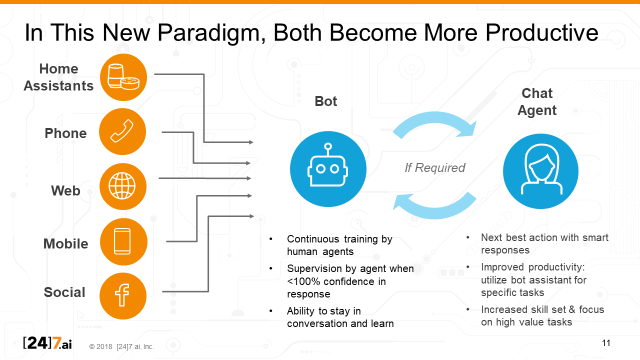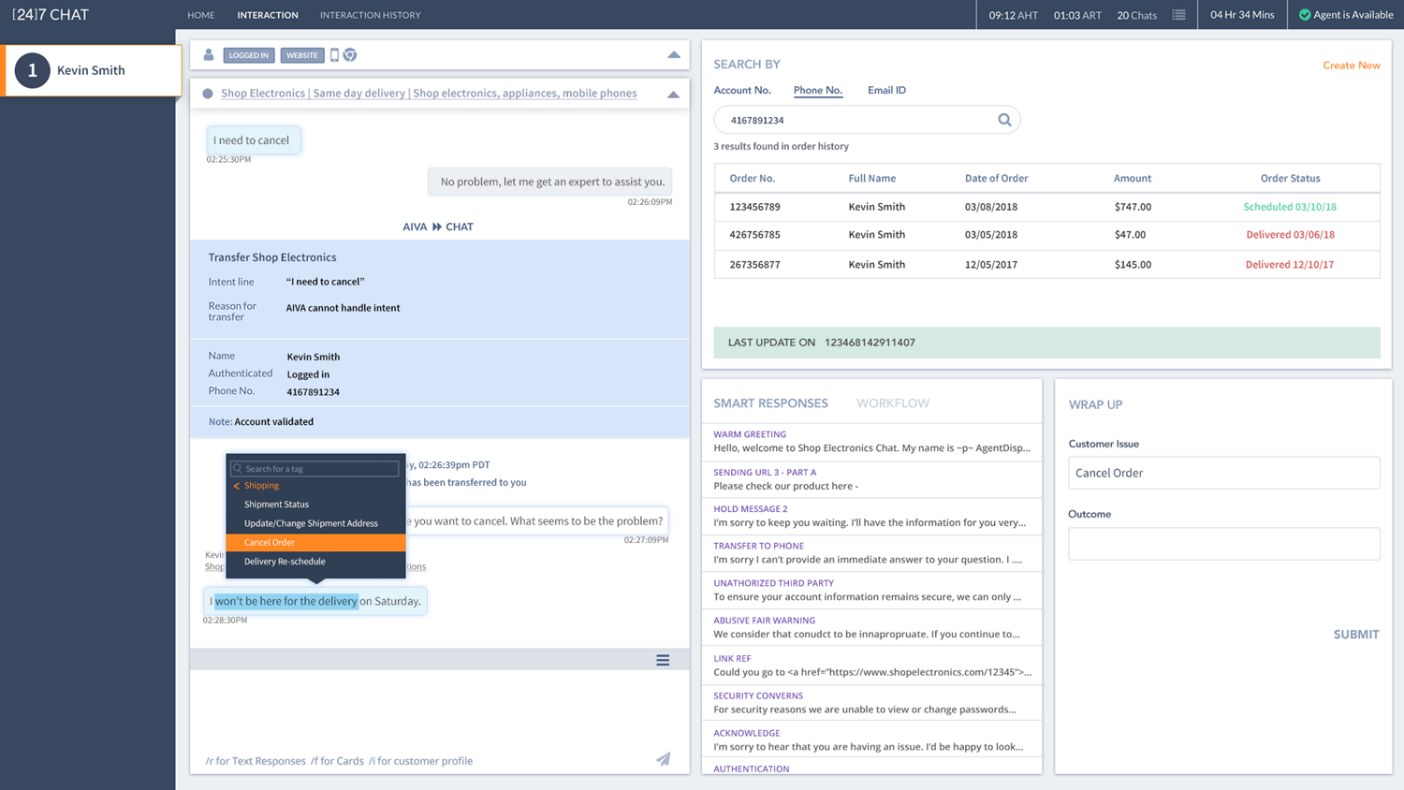
The Symbiotic Future of Customer Service
The Symbiotic Future of Customer Service
I began 2018 with a few predictions about the ways I expected AI to shake out this year. One of the trends that I discussed was companies embracing the concept that humans would work hand-in-hand with artificial intelligence to improve customer experience. I am happy to say that’s beginning to happen.
Digital transformation remains a top priority for businesses, and consumer-facing companies are deploying AI to automate customer service. They are doing so by deciphering huge amounts of customer data, comparing on-domain and off-domain data, and running that data through algorithms to determine consumer intent. Once they do, they can personalize the customer experience. Only by using artificial intelligence can companies process this immense amount of data. It’s simply not possible to apply enough humans to do this kind of analysis.
But companies can’t live by AI alone. By itself, it cannot succeed. A simulation of human intelligence by machines, designed to perform human-like tasks, ironically requires a lot of support from humans. A critical criterion for digital self-service is to maintain the quality of the interaction. Failed digital self-service leads consumers down an unhappy path, and ultimately abandonment of self-service channels. For the business, this results in increased call volumes, which defeats the purpose of automation.
Human Guidance is Critical
AI is far from taking over the world. Rather, it is like a child that needs constant education and supervision to learn and perform this task of training. For the foreseeable future, humans will have to feed AI systems with experiences and situations to ensure the machine has references and large resources of knowledge to draw from. Humans will regularly have to intervene to provide the answers that bots can’t, or don’t feel confident about. In most cases, bots are not currently capable of handling and completing complex transactions that ensure that a customer’s overall experience is both smooth and satisfactory.
The most important aspect of the human intervention however, is empathy. Human agents are the ones who differentiate a brand’s customer service, not the bots. While some bots are being trained in sentiment and emotions, it only helps them deal with rudimentary problems, while more nuanced interactions will require a human. I firmly believe that bots will get there, but this will require extensive training by humans, using real human experiences, over a longer period of time.
Both Humans and Bots Benefit
One of the biggest beneficiaries of blending bots and agents will be your agents themselves. Not only will bots augment agent tasks by providing data, insights and analysis; but they will reduce the average handle time to ensure more interactions are completed with more efficiency per interaction. But in the digital age, AHT really isn’t the best metric. It’s about Total Customer Interaction Time. That decreases, too. The bot-assisted augmented customer experience ensures less waiting time for consumers, thereby increasing overall self-service adoption, which is critical to digital transformation.
Once bots start handling the more mundane and repetitive customer support tasks, human agents can focus on developing their skill sets and focus on high value tasks which will lead to increase overall agent satisfaction and positively impact customer retention.

An example of blended AI would be a shopper trying to buy a product. After being guided by an informational bot, let’s say the consumer has to turn to a live agent for help when the credit card is charged for an incorrect transaction. Here’s an example of how that might play out:
Chelsea is looking to get into photography and has googled DSLRs for beginners
After browsing down the list of results, some review sites, some blogs, she finally ends up on Shop Electronics
Chelsea bought her phone at Shop Electronics a month ago and is automatically logged in to their website
VA: Hello Chelsea, I’m Shop Electronics Virtual Assistant. Are you contacting us about your phone or something else?
Chelsea: I’m looking to get into digital photography
VA: We have a great selection of entry level DSLRs we can show you, would you like to view our top- rated options? [View Options]
Chelsea clicks to view options reviews and adds to cart
VA: Great choice! We offer an extended warranty; would you like to add it to your order?
Purchase is completed
Later, Chelsea sees her credit card bill and notices charge that she did not approve
Chelsea opens Shop Electronic VA on her mobile phone
Chelsea: You charged me for something I didn’t want
VA: Sorry! Let me look into this right now.
Image in corner changes from a bot to a human
Chat Agent: Hello Chelsea, I understand you have been charged for an item you didn’t want – there are 2 purchases made in the last month that are both pending delivery. I’ve pushed a list to your screen so you can click on the purchase that you didn’t want.
Chelsea clicks on the second item
Chelsea: Why did this happen?
Chat Agent: You may have added this item to your cart by accident and purchased it when you used our “Quick Checkout”
Chat Agent: Would you like me to adjust your settings to have the system double check your order before final purchase?
Chelsea: Yes please!
How does the bot learn from the human?
In this new world, bots learn from human agents as well. Every time the bot transfers to a human, the human tags the interaction so that the bot can learn. Not only does the bot learn to better interpret the consumer’s questions and comments, but it also learns to take a more educated guess at what the right response might be. Over time, the bot learns to emulate the skills of a company’s best human agent. This turns agents into “super agents,” supported by a great team of bots behind them.

The right blend of virtual agents and human chat agents can not only lead customers to a happier path, but can also yield significant cost savings, and even increase sales. This is just the beginning of a collaborative and symbiotic customer experience ecosystem that will witness humans and AI working side-by-side.
Trending
-
1 SEO Mistakes That Could Be Costing Your Shopify Store Sales
Daniel Hall -
2 Strategies for Safeguarding Assets and Investments
Daniel Hall -
3 The Role of PR Firms in Crisis Management and Damage Control
Nitish Mathur -
4 How to Make Appealing Visuals for Your E-commerce Store
Daniel Hall -
5 The Competitive Landscape of Low-Cost Carriers in Belgium: TUI Fly Belgium’s Position
Daniel Hall





Comments